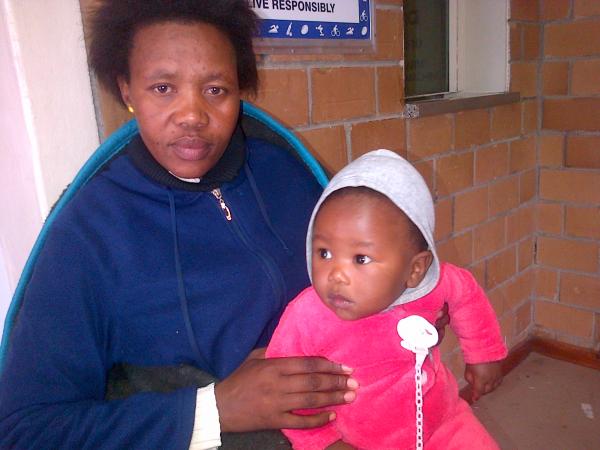

Neliswa and Olwaba Qaneka. Baby Olwaba was rumoured to be dead, but she is alive and well. Photo by Pharie Sefali.
4 June 2014
It’s cold and raining in Cape Town tonight. Ice particles formed on the ground outside the Nomzamo Community Hall in Strand where hundreds of residents, whose homes were demolished over the last two days, are sheltering.
But a baby rumoured to have been shot dead by police on her mother’s back during the demolition of the shacks yesterday is alive and healthy.
A community leader announced that the baby had died last night to Nomzamo residents staying at the hall. But GroundUp tracked down the mother whose baby was thought to have died, Neliswa Qaneka, who confirmed that her six-month-old daughter Olwabo is alive and healthy.
Qaneka said during yesterday’s violence she had been shot in the leg by police with a rubber bullet while she was running with her baby on her back. “Within a few seconds after I started running I got hit by a rubber bullet on my right leg and I fell on the ground. While I was falling my baby fell too and immediately I screamed and cried Umntwana wam (my child)! But people were still running and there was teargas all over. No one came to my rescue even though they saw me.”
She ran to a friend’s house and while she was there an ambulance passed by to attend to an injured man. Qaneka says when other residents saw the ambulance they assumed that it was coming for her. “Some community leaders told people that the baby died but it was just an assumption. It was never confirmed with me,” she said.
She is now staying at the community hall, with other Nomzamo residents whose shacks have been demolished by the SA NAtional Roads Agency (SANRAL) on whose land they were living. Qaneka says she has asked other people to look after her baby because she is in pain from the injury.
At about 6pm residents in the hall were given soup and bread by the City of Cape Town’s disaster management services. Some residents said they were sick and they had not received blankets.
The Ministry of Human Settlements published a statement earlier today saying that Minister Lindiwe Sisulu will “establish an enquiry to investigate all processes and procedures followed by all involved until the removal was authorized by the High Court and subsequently implemented this week.”
The statement also said, “the City of Cape Town and SANRAL could have handled the dispute and the whole relocation process differently with the main concern being the interest of the people, children and the elderly.”
This evening, Sisulu arrived at Nomzamo Community Hall and held a meeting with community leaders, which was still ongoing at the time this article was published.
A statement by the City of Cape Town released today said that the evictions were the result of “the enforcement of an interdict obtained by SANRAL, against individuals who illegally invaded their land after the time of the issuing of the court interdict.” It continued, “It is SANRAL and the Sheriff that need to answer as to why they timed the enforcement of [the] interdict in the middle of a major storm.”
The statement said that only the City had responded to the “humanitarian situation created by the enforcement of the interdict.” The City had made community halls available for seven days and provided emergency relief.
Civil society organisations Equal Education, Social Justice Coalition and Ndifuna Ukwazi have started a Lwandle Solidarity Campaign. They have called for blankets, mattresses, food, clothes, umbrellas and raincoats to be dropped off at The Bookery at 63-89 Plein Street in Cape Town.
The organisations released a statement condemning the destruction of homes and lives in Lwandle and criticising both SANRAL and the City for the events of the past few days.
They said, “No eviction order was ever granted by a court for the removal of these people. Rather an interim interdict was granted on 24 January against those ‘intending to occupy the land.’ It specifically excluded those ‘currently occupying the property at the date of the granting of this order’.”